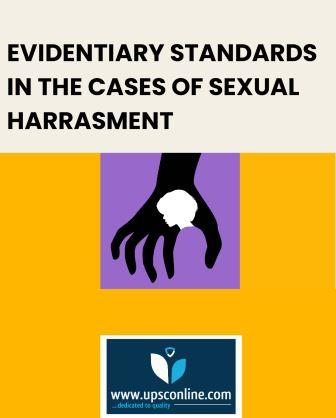In recent investigations of some sexual harassment cases, police & other investigating agencies have asked for video & audio “proof” of sexual harassment from the complainants. It raised the serious concerns about the investigation protocols that are followed by the police in sexual offences.
Indian investigative authorities are repeatedly facing allegations of being insufficiently sensitive & victim centric.
The Sexual Harassment of Women at Workplace (Prevention, Prohibition and Redressal) (POSH) Act, 2013 provides a comprehensive framework for addressing & preventing sexual harassment at various workplaces.
It requires all workplaces having 10 employees or more to set up a body known as an internal complaints committee (ICC) to conduct enquiries and issue remedies.
The protocols for the investigation of sexual offences, which are based on the mandate that due care be taken to prevent further traumatisation of victims.
These protocols acknowledge that such offences, more often occur in private or isolated environments, with no evidence other than the testimony of the victim.
Supreme court in a recent cases , emphasised that in the cases of allegation of sexual harassment, or similar criminal allegation, the Court should pass on the burden of investigation on police, instead of stressing the complainants, especially if the complainant would not be in a position to retrieve any evidence.
The POSH Act also acknowledges that, instances of sexual harassment often occur in circumstances where evidence is scarce.
The ICC can exercise discretion in the choice of procedure to be adopted in proceedings, provided that, it should follow the principles of natural justice.
The ICC is thus purposely not bound by strict procedural & evidentiary standards of the Indian Evidence Act, 1872.
Criminal courts have consistently upheld the principle that a prosecutrix of a sexual offence cannot be put on par with an accomplice. She is in fact a victim of the crime. The Evidence Act nowhere says that her evidence cannot be accepted unless it is corroborated in material particulars.
The Supreme Court, in Vijay alias Chinee v State of Madhya Pradesh (2010), ruled that a court is duty-bound to treat cases involving sexual harassment or molestation with utmost sensitivity.
Evidence of a victim in such cases is enough for conviction and courts should not ordinarily require corroboration, if such evidence inspires confidence.
In the cases where tangible evidence is lacking, the court system relies on various forms of evidence to establish the credibility of the allegations.
This includes testimonies from victims, medical reports or expert opinions of any physical or psychological harm, corroborating statements of other witnesses or victims & other circumstantial evidence.
Complaints of sexual harassment can therefore be raised without any evidence, and a complaint can be taken up and decided solely on the testimony of a victim.
Invoking either the POSH Act or the Indian Penal Code for addressing sexual harassment is a strategic choice.
While the substantive law largely overlaps, the procedures and remedies vary widely. In this case, there was no recourse to the POSH Act, which often also provides a swifter outcome than a full-fledged criminal trial.
In Bhuwan Chandra Pandey v Union of India and Ors (2020), the High Court of Uttarakhand, dealing with the finding of an enquiry committee, relied on the sole testimony of the victim along with circumstantial evidence. In the absence of direct evidences, there was circumstantial evidence given by other witnesses.
The challenges faced by the complainants in many cases & the approach of the investigating agency are indicative of a trend that risks discouraging other victims from reporting any such instances, it also pushes women out of workplaces.



0 Comments